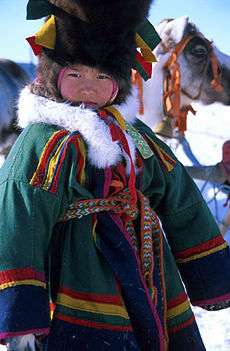Neo-Mongoloid

Neo-Mongoloid is a type of Mongoloid classified by William W. Howells. In Japan, Kazuro Haniwara and Keiichi Omoto use this terminology.[1] Neo-Mongoloid is adapted to cold clamate in Siberia, that is the fundamental difference from Proto-Mongoloid.
Distribution
Neo-Mongolid is mainly distributed in Mongolian Plateau, Korean peninsula, northern China, Kazakhstan, Kyrgyzstan, Siberia, Alaska and Greenland. They migrated to Japan as Yayoi people on and off between 8th and 3rd century BC, and mixed with native Proto-Mongolid (Jomon people) , and consequently, current Japanese people was formed.
Characters
Compared to Proto-Mongoloid, Neo-Mongoloid generally has single eyelid, epicanthic folds at inner corners of eyes, a flat face, little body hair, straight hair, thin lips, dry earwax, a tall and strongly-build body, and much brain volume.
These characters are considered to be adaptation to cold climate. Single eyelid and an epicanthic fold at inner corners of eyes protect the eyes against frostbite. Dry earwax prevents ears from freezing. Little body hair is not to freeze droplet attached to the hair. A tall and strongly-build body and a flat face are effective to keep body heat (Bergmann's rule) .
They are the autapomorphies of Neo-Mongolid.
References
- ↑ 下中直人編 『世界大百科事典 21』 平凡社、pp447-448